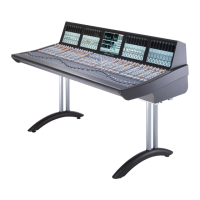.>8/)'1+6:/7+2+398
'-+ ? +)9/437+5'7'9/43 389'11'9/43'3:'1
&$% $ %
The console surface and the Alpha-Link I/O units do not contain cooling fans so can be located in recording areas.
The optional larger RIO chassis is fitted with temperature controlled low-noise fans so will requires a degree of noise
isolation from recording areas.
Noise figures for the individual units are listed in Appendix A.
# % #"&#%$
It is unlikely that additional air conditioning will be required after installation of the C10 HD console (with its typical 300W
dissipation). It is possible however, that if all studio equipment is taken into consideration, particularly if lighting equipment
is included, that the combined heat output could be sufficient to cause the temperature to rise to uncomfortable levels.
If a RIO is being used for multiple microphone inputs its heat dissipation can equal that of the console and it should
therefore be operated in an air-conditioned environment.
Environmental requirements and power dissipation figures for individual system components are listed in Appendices A and E.
&%
Cable ducting will be required between the console and any outboard racks and the recording areas. Ducting provided
should be of sufficient size such that approximately 100mm x 50mm can be allocated for console surface connections. This
should be sufficient for the remote I/O cabling and for the T/B Mic etc. in addition to the console connections.
$#' $$
Access to sub-assemblies within the frame is from either the front or above the console. If the console is being built into
restricted space – as in some mobile installations – then sufficient clearance must be available above the top of the console
to allow access to the fixing screws which secure the top trim.
Also see the clearance diagram on page 2-13.

